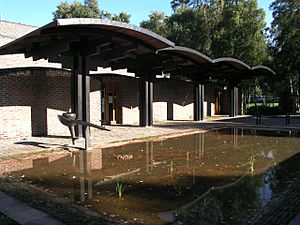Sigurd Lewerentz facts for kids
Sigurd Lewerentz (born July 29, 1885 – died December 29, 1975) was a famous Swedish architect. An architect is a person who designs buildings. Lewerentz designed many important buildings in Sweden. He is known for his simple yet powerful designs.
Contents
Life and Work of Sigurd Lewerentz
Sigurd Lewerentz was born in a place called Sandö. This was in the Bjärtrå area of Västernorrland County, Sweden. His parents were Gustaf Adolf Lewerentz and Hedvig Mathilda Holmgren.
Early Training and Career
Lewerentz first studied to be a mechanical engineer. He went to the Chalmers University of Technology in Gothenburg. This was from 1905 to 1908. After that, he learned about architecture in Germany.
He opened his own architecture office in Stockholm in 1911. He became friends with another architect named Gunnar Asplund (1885–1940). They worked together on a big project. They won a competition to design the Stockholm South (Woodland) Cemetery. This competition happened in 1914–15. Both architects started this project. However, Asplund finished the later parts by himself.
Lewerentz and Asplund were also the main architects for the Stockholm International Exhibition (1930). After this, Lewerentz felt disappointed. He stopped designing buildings for many years. From 1940, he ran a factory. This factory made windows and other building parts that he designed himself.
Important Buildings and Awards
Sigurd Lewerentz worked with Erik Lallerstedt and David Helldén. Between 1933 and 1944, they created a masterpiece. This was the Malmö Opera and Music Theatre (Malmö Opera och Musikteater). It is considered one of the best examples of functionalist architecture. Functionalist architecture focuses on how a building works.
The entrance hall of the Malmö Opera is very beautiful. It has open spaces and lovely marble staircases. It also has many artworks by artists like Carl Milles and Isaac Grünewald. In 1950, Lewerentz received the Prince Eugen Medal for his architecture. This is a special award in Sweden.
Later Church Designs
In the last ten years of his life, Lewerentz designed two churches. These churches brought him back into architecture. One was St. Mark's Church in Björkhagen, Stockholm (1956). The other was St. Peter's Church in Klippan, Scania (1963–66).
St. Peter's Church is in a small town in southern Sweden. It has a square shape. This shape was meant to create a more personal feeling during church services. It reminded people of early Christian traditions. These churches showed Lewerentz's interest in simple and basic designs. This was clear in the details of the buildings. It was also seen in the materials he chose, the way light entered, and how the spaces were arranged.
Lewerentz continued to work on design competitions. He also designed furniture. He kept working until shortly before he died in Lund, Sweden, in 1975.
Exhibitions
- Sigurd Lewerentz, 1885 - 1975. Stockholm: Arkitektuurmuseet, 1985.
Images for kids
See also
 In Spanish: Sigurd Lewerentz para niños
In Spanish: Sigurd Lewerentz para niños





